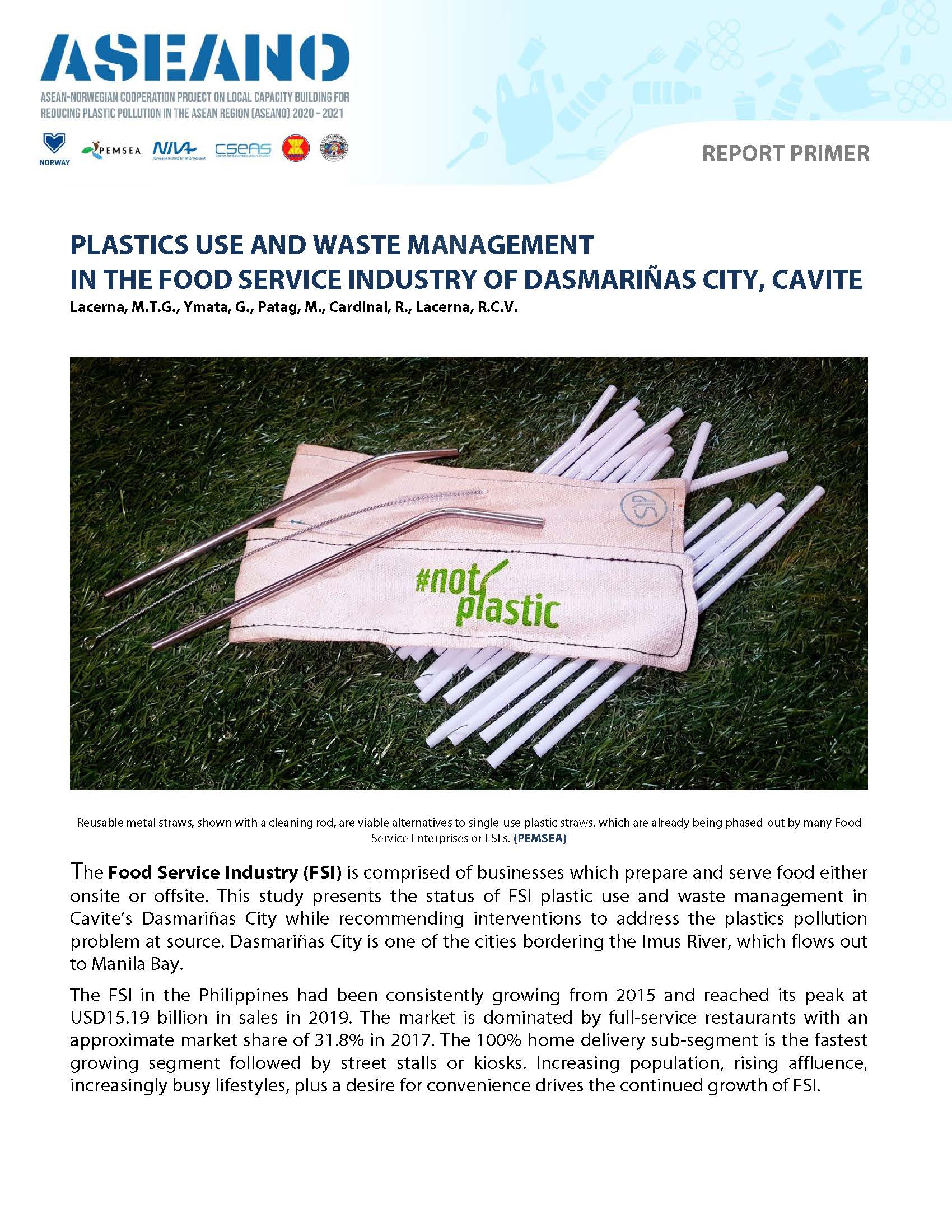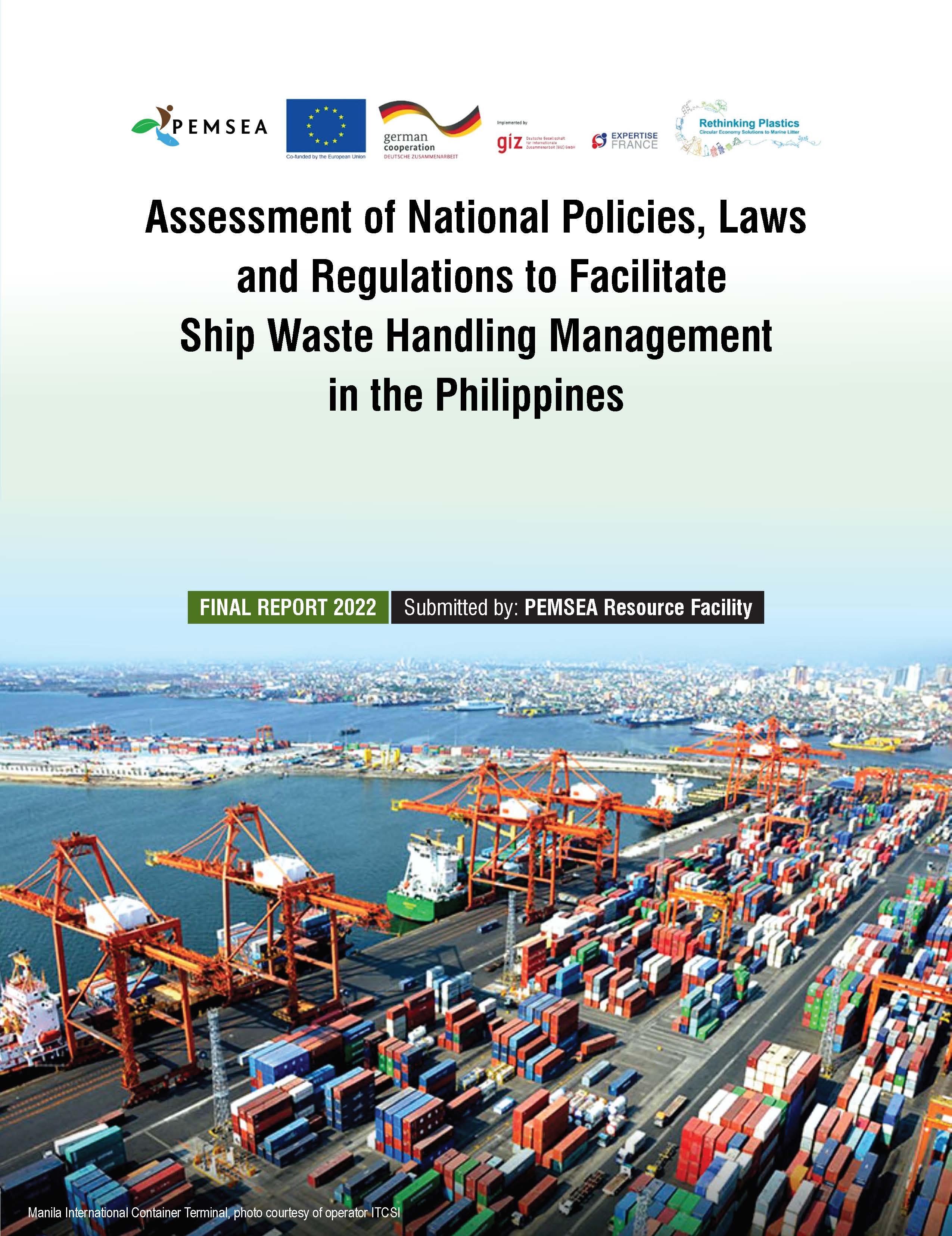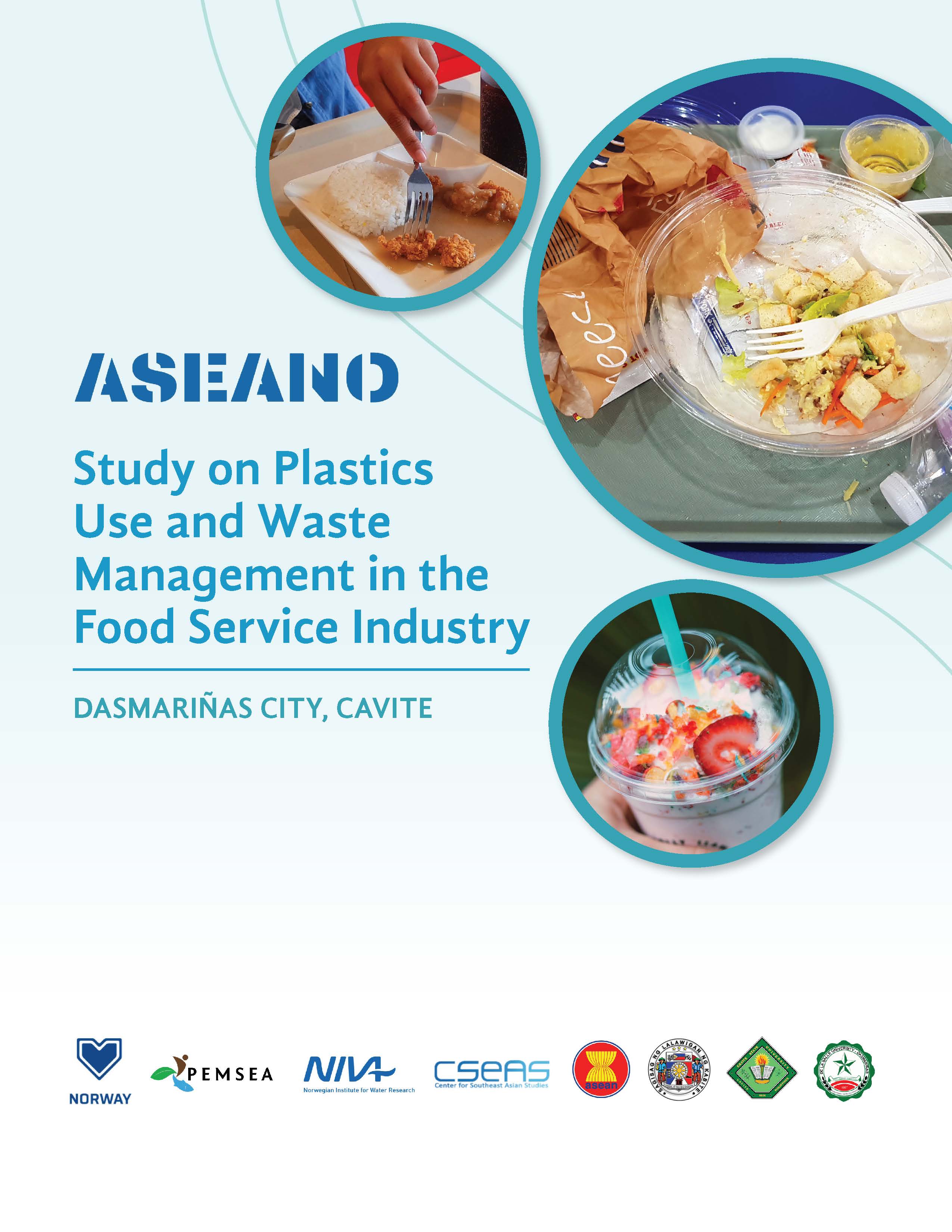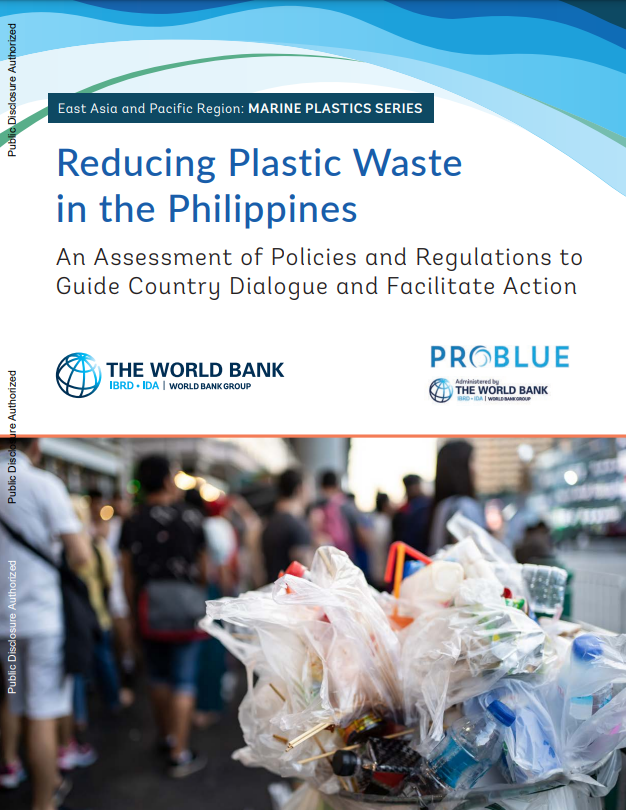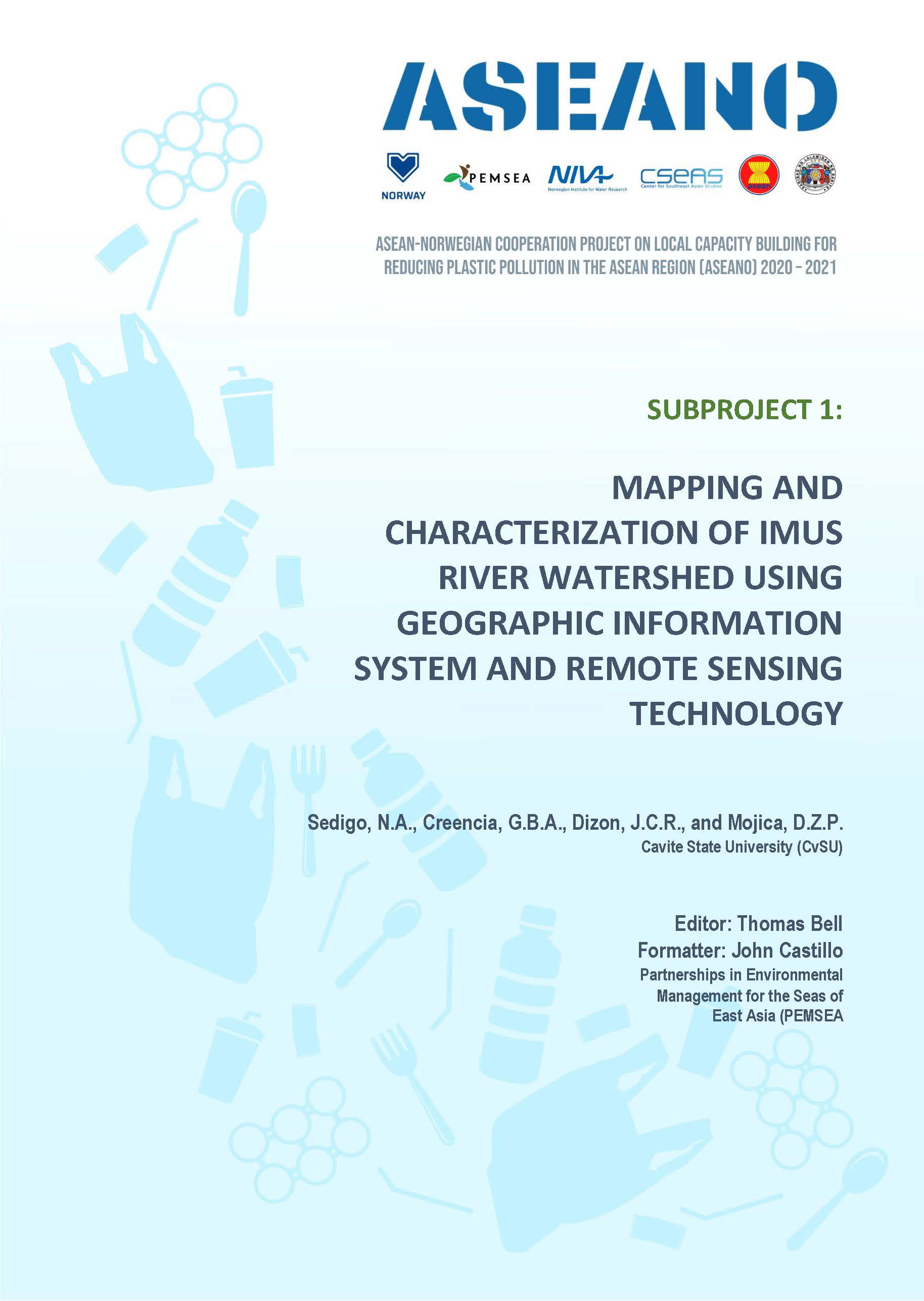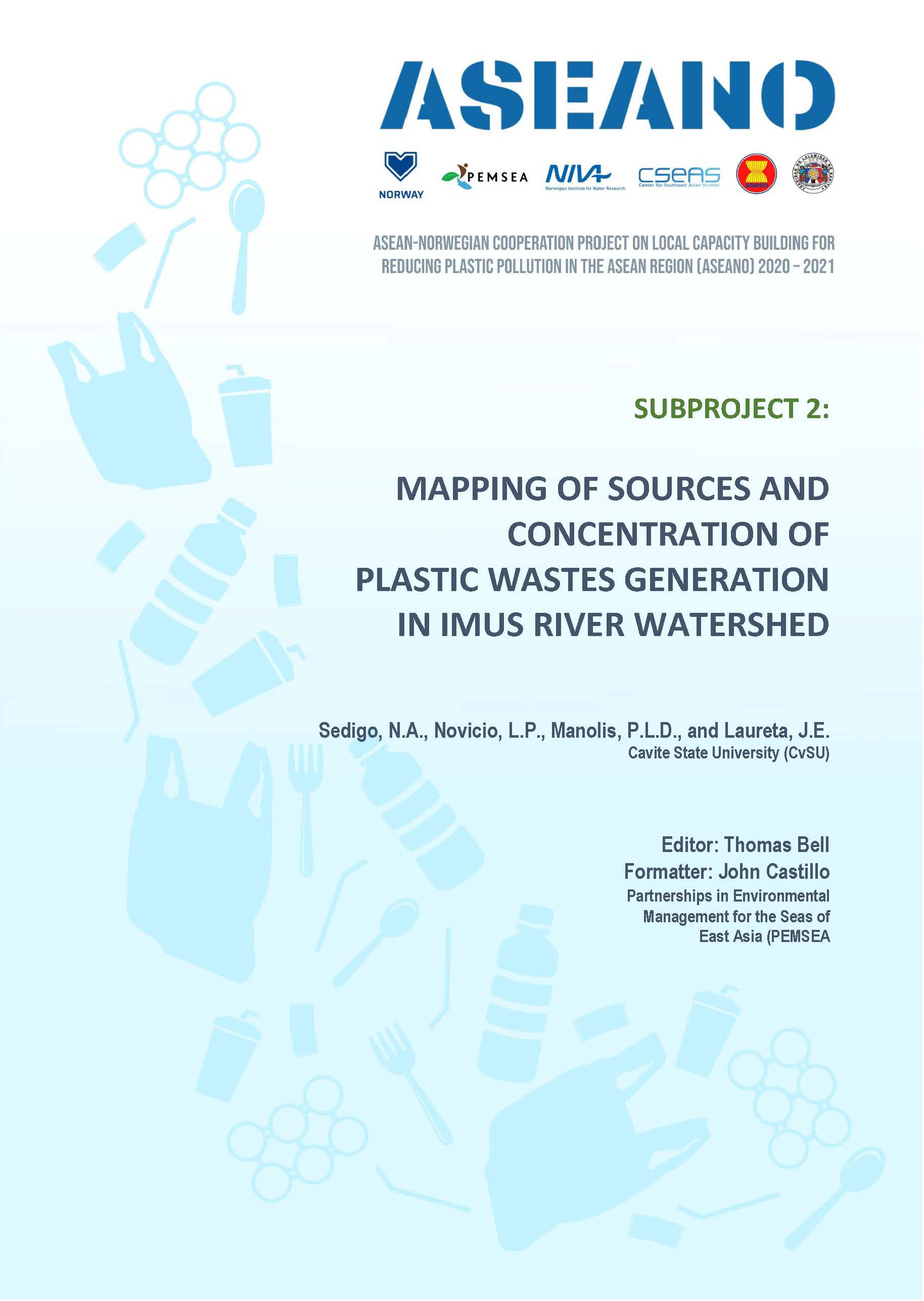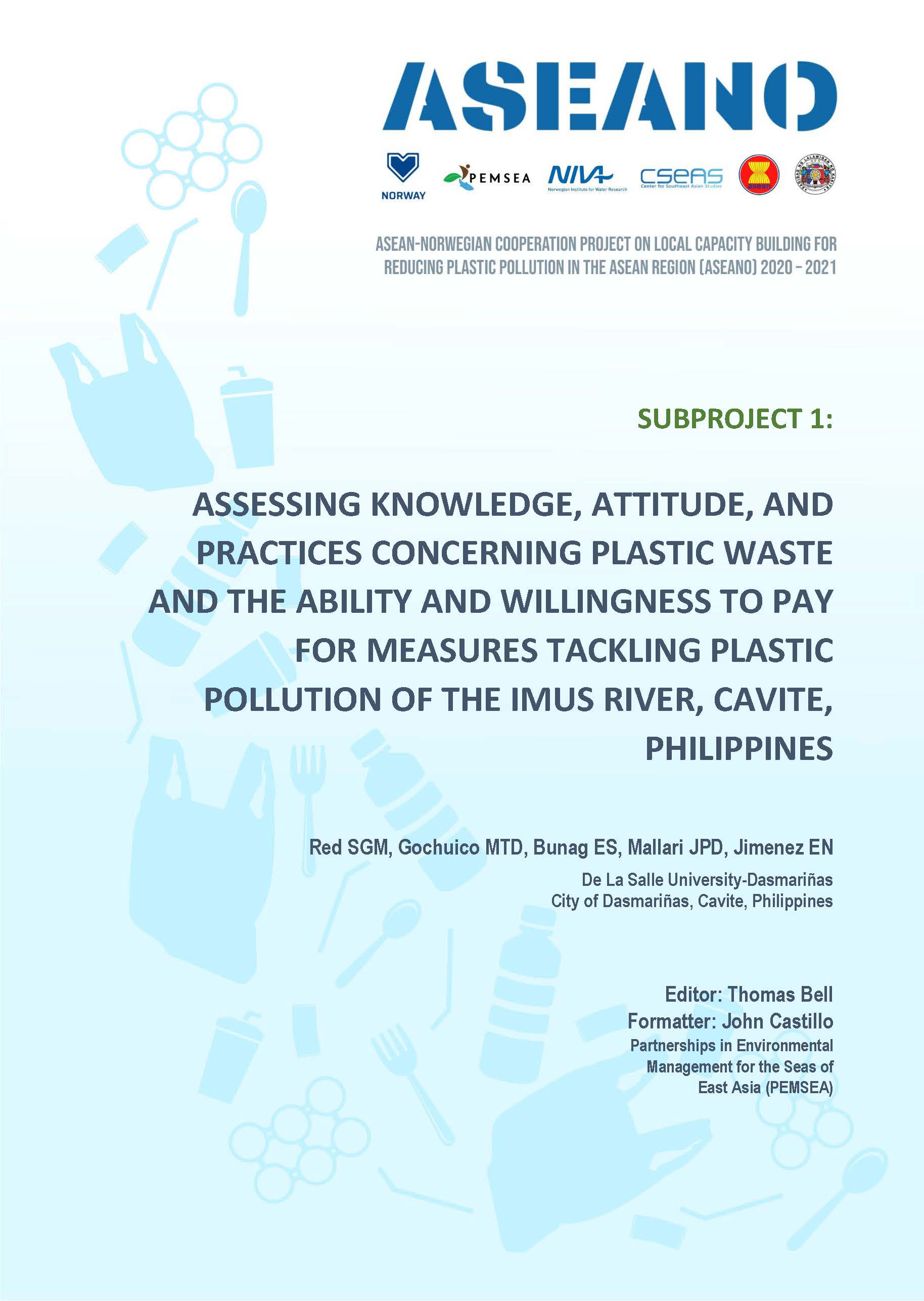
Breadcrumb
ASEANO Primer: Study on Plastics Use and Waste Management in the Food Service Industry
Accessible summary for the ASEANO Project Report: Study on Plastics Use and Waste Management in the Food Service Industry (https://pemsea.org/resources/publications/reports/aseano-project-report-study-plastics-use-and-waste-management-food).
Assessment of National Policies, Laws and Regulations to Facilitate Ship Waste Handling Management in the Philippines
As an archipelagic country, the maritime industry plays a critical role in moving goods and people across the more than 7,000 islands, as well as linking the Philippines to international trade and commerce. The maritime industry therefore serves as an integral component of the country’s socioeconomic development and in establishing linkages to the economic growth areas in the East Asian region and beyond. The ports and shipping sector in particular is one of the key ocean-based industries that contributed 12 per cent of the gross value added of the country’s ocean economy in 2016 or around USD 1.4 billion (in constant 2012 prices) employing around 700 thousand people. Of the 1,300 ports in the country, 1,000 are government owned and the rest are privately owned. In addition to seaports, which serve as major hubs for international and domestic/interisland cargo and passenger vessels, there are also fish ports, feeder ports or commercial ports located in many coastal areas around the country. Fish ports, which are also referred to as landing centers provide the facilities for the distribution of fish (PEMSEA and DENR, 2019).
ASEANO Project Report: Study on Plastics Use and Waste Management in the Food Service Industry
This Baseline Study covers food service establishments (FSEs) in Dasmariñas categorized as (i) full-service restaurants, with full menu and waiting service, (ii) limited-service restaurants or quick service restaurants (QSR), with full menu but pay-as-you-order (iii) cafes/bars/pop-ups (selected menu with few chairs and tables), (iv) kiosks and stalls (purely retail, to be consumed elsewhere), and (v) catering or 100% home delivery. It excludes those unreported, unregulated and unregistered FSEs. It also covers the 6 types of food-grade plastics: (1) Polyethylene Terephthalate, (2) High Density Polyethylene, (3) Polyvinyl Chloride, (4) Low Density Polyethylene, (5) Polypropylene, and (6) Polystyrene.
Methodologies used included surveys conducted of local government units (LGU) and FSEs, field observations, focus group discussions and stakeholder meetings, desk research and interviews. An inception meeting with PEMSEA and the provincial and local government of Cavite was conducted on November 8, 2021. It was followed by a stakeholders’ meeting with public and private stakeholders including the academe was held on November 25, 2021 upon project commencement to agree on the objectives, expected outputs and timelines as well as gather valuable inputs that shaped the contents of this Baseline Study. Follow-on Interviews were also conducted as needed. Considering the pandemic situation, research relied heavily on online data and information as well as reports from institutions. The surveys on FSEs and the Local Government Units (“LGUs”) were conducted from January 21 to February 10, 2022. The surveys determined ‘on the ground’ the sentiments, perceptions and practices of the FSEs. LGUs were also surveyed to determine challenges they faced in addressing the plastic waste issue and implementing their respective plastic waste ordinances.
Reducing Plastic Waste in the Philippines : An Assessment of Policies and Regulations to Guide Country Dialogue and Facilitate Action
Completed by the World Bank and PEMSEA.
Solid waste management (SWM) in the Philippines continues to be hampered by gaps and issues despite the passage of the Ecological Solid Waste Management Act of 2000. One of these issues involves plastic waste whose impacts have extended beyond the country’s terrestrial boundaries. Studies have shown that the Philippines, together with China, Indonesia, Thailand, and Vietnam, accounts for 55 to 60 percent of plastic waste entering the ocean. Globally, the Philippines has one of the highest rates of mismanaged plastic waste recycling, with only about 28 percent of the key resins it consumed in 2019 being recycled. Unrecycled plastics are disposed of in dumpsites and landfills, remain as litter, or accumulate in sewers, drainage systems, and rivers before being discharged into surrounding marine water bodies. This study assesses national-level policies governing the management of plastics waste in the Philippines. The study aims to support the government’s efforts to improve the management of such waste and to facilitate circular-economy practices. The study included a desk review and analysis of current SWM conditions, existing policies, and current and pending legislation related to recycling and plastics waste management. Consultations with key stakeholders in the private and public sectors in plastics waste management supplemented the review.
PEMSEA Annual Report 2021: From Recalibration to Action
The link between ocean health and human health was foremost in our minds in 2021 as we experienced another year of the global pandemic. Mental, emotional, and physical well-being were tested with successive lockdowns and mobility restrictions which caused some temporary setbacks in many of our initiatives. Nevertheless, with collective determination, grit, and perseverance to succeed, Partnerships in Environmental Management for the Seas of East Asia (PEMSEA) managed to have a relatively good year with many accomplishments that can spur us to greater action in the coming decade.
Notable highlights of the year included the successful organization of a nine-month-long, blended (online and face-to-face) East Asian Seas (EAS) Congress 2021 hosted by the Royal Government of Cambodia. It culminated in the 7thEAS Ministerial Forum, where 11 PEMSEA country partners reaffirmed their commitment to the EAS partnership and agreed to endorse the development of the PEMSEA Roadmap to 2030 that would reset and recalibrate actions to vigorously promote the blue economy pathway in the region and help fulfill our national, regional, and global commitments.
Much has been done to implement the region’s commitment to the United Nations (UN) Sustainable Development Goals (SDGs), but much more is needed to attain our vision of a healthy ocean, people, and economies.
On a fun note, we had to be skillful in adaptive management, embrace uncertainty, and learn to be innovative and creative in the online delivery of knowledge products and technical services to implement the targets under the Sustainable Development Strategy for the Seas of East Asia (SDS-SEA).
Allow us to help you look back on the year that set us off on a new decade of powerful actions through this report.
ASEANO Project Report: Mapping and Characterization of the Imus River Watershed
River systems have been identified as major pathways and transporters of wastes, including plastics, that ultimately end up in the oceans. The Imus River Watershed (IRW) is located in the Philippine Province of Cavite, one of the provinces in the CALABARZON Region of southern Luzon. This study delineated and mapped the physical boundaries of the Imus River watershed and determined the topographic features, stream characteristics, geomorphology, political subdivisions, barangay communities, population distribution, land use and land cover, and hydro-climatic characteristics of the watershed. Both primary and secondary data sources were used in making comprehensive land use maps, population maps, and hydroclimatic data analyses.
The boundary of the Imus River Watershed was initially established through an unsupervised delineation process using a digital elevation model of Cavite with a 5-meter resolution in ArcGIS. Sangley Point Synoptic Station in Cavite City and the CvSU-PAGASA Agrometeorological Station in Indang were used to define the general hydroclimatic condition of IRW due to their close proximity to the watershed. The total drainage area of IRW is 11,259.80 hectares, covering portions of Tagaytay City, Amadeo, Silang, Dasmariñas, Imus City, Bacoor City and Kawit. Elevation within the watershed ranges from 0 to 655 meters above sea level. The lowland area covers parts of Kawit, Imus City, and Bacoor City; a central hilly area covers parts of Imus City, Bacoor City, and the majority of communities in Dasmariñas and Silang. The upland area covers parts of Silang, Amadeo, and Tagaytay City. There were 56 perennial streams identified with a total length of 186.15 km and 36 river segments. The Imus river system is a combination of headwaters and medium-sized streams. The sub-watersheds, labeled A, B, and C, have drainage densities of 1.15 km/km2, 1.95 km/km2, and 1.41 km/km2, respectively. The sub-watersheds A and C have stream frequencies of 0.20/km2 and 0.25/km2 while sub-watershed B has a stream frequency of 0.39/km2. In alphabetical order, these sub-watersheds have bifurcation ratios of 5, 3.31, and 2.5, elongation ratios of 0.33, 0.26, and 0.43, and circulatory ratios of 0.18, 0.11, and 0.26.
A total of 222 barangay communities are located within the boundaries of the watershed with a total population of 1,351,057 in 2015. 90.67% of the province is classified as alienable and disposable land, while the remaining forest land represents only 9.33%. Alienable and disposable lands are further classified as production land (55.24%) and built-up areas (44.76%). The Sangley Point Synoptic Station has a normal mean temperature of 28.53°C while the CvSU-PAGASA Agromet Station has a normal mean temperature of 26.20°C. The average total annual rainfall recorded at Sangley Point Synoptic station and CvSU Agromet Station were 2,265.69 mm and 2,483.05 mm, respectively. The average flow during wet season was 1,601.84 liters per second, while the average flow during dry season was 1,337.42 liters per second.
ASEANO Project Report: Mapping of Sources and Concentration of Plastic Waste in the Imus River Watershed
The sources of plastic wastes and areas of expected high levels of plastic waste generation were mapped in the Imus River Watershed in the Province of Cavite, in the Philippines. Different sources of plastic waste were identified, and used to estimate the magnitude of plastic waste generation. Information on the major sources of plastic waste were obtained from the 10-Year Solid Waste Management Plan of the seven cities and municipalities located within the boundaries of the watershed. Remote sensing technology was used to identify the coordinates of different potential sources. For higher resolution, Google Imagery was used in preparing base maps which were imported and georeferenced in ArcMap. A 7-day waste characterization study in three selected barangays was conducted to determine the average amount of plastic waste generated per household. This data served as inputs for a hotspot analysis in ArcGIS to identify plastic waste generation hotspots within the watershed. The Imus River system traverses seven cities and municipalities that include parts of Tagaytay City, Silang, and Amadeo in the upland areas, a large part of the densely populated and urbanized cities of Dasmariñas and Imus City in the central hilly areas, and portions of the lowland City of Bacoor and the coastal Municipality of Kawit. It has a total drainage area of 11,259.80 hectares. A total of 222 barangay communities were identified within the boundaries of the watershed with a total population of 1,351,057. The major sources of waste in the watershed were primarily households, followed by commercial, institutional, and industrial establishments. The total number of commercial, institutional, and industrial establishments identified was 778, and a total of 54 waste storage facilities were found in the watershed. From the 7-day characterization study in three selected barangay communities, an average of 113.03 kg of plastics was generated daily by the households in Barangay Burol 1, Dasmariñas City; 9.17 kg/day in Barangay Mabolo 1, Bacoor City; and 29.29 kg/day in Barangay Maitim 2nd Central, Tagaytay City. An average of 0.17 Kg/day per household of plastics were generated in the watershed and 0.05 Kg/day per capita. A cluster of high plastic waste generating barangays was identified in Dasmariñas City, where various tributaries of the Imus River converge. This combination is likely to create a significant hotspot for waste leakage. Clusters of low plastic waste generating barangays were identified in parts of Imus, Kawit, and Bacoor. These cold spots should not be ignored, as increasing plastic waste generation could exceed capacity and push them into future leakage hotspots.
ASEANO Project Report: Survey on Plastic Litter Along Imus River
With technical guidance/assistance from PRF, NIVA, and other partners, DLSU-D conducted a survey on plastic litters in the waters of the Imus River located in at least one barangay of five cities/municipalities (Municipality of Silang, City of Dasmariñas, City of Imus, City of Bacoor, and Municipality of Kawit). The data in this report were based on on-site observations and the collection of plastic litters during dry and wet months using. Both visual and active trawl sampling methods were used. Sampling sites were selected to represent the upstream, midstream and downstream of the entire stretch of the river located along five (5) municipalities/cities.
ASEANO Project Report: Assessing Knowledge, Attitudes and Practices Concerning Plastic Waste Along Imus River
This study tackles the Imus River, one of the six major river systems in the province of Cavite. The main river is 38.4 kilometers long and stretches from Tagaytay City in the northern upland region, through the municipality of Silang, the cities of Dasmariñas, Imus, and Bacoor, and lastly the lowland areas of Bacoor and the municipality of Kawit, where it empties into Bacoor Bay. Within these cities/municipalities are barangays that find the river useful for domestic, tourism, and industrial purposes. DLSU-D surveyed different stakeholders (households, LGUs, and households with small businesses) in 14 selected barangays in the five cities/municipalities (Silang, Dasmariñas City, Imus City, Bacoor City, and Kawit) located along the Imus River. This study determined the stakeholders’ knowledge, attitudes, and practices (KAP) related to plastic pollution problems including its impact, management, and their reasons for using plastic. It also assessed the economic value of the river to the community by identifying and analyzing economic benefits like employment, livelihood, goods, and services derived from the Imus River. Lastly, it determined the Ability to Pay (ATP) and Willingness to Pay (WTP) for better waste and pollution management of the selected communities dependent on the river for their day-to-day needs. Both quantitative and qualitative data were obtained for the study through surveys and interviews. Recommendations for a community-based plastic waste management program were made based on the collected data on KAP, ATP, and WTP of different stakeholders.
